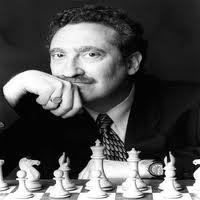
Pandolfini's Puzzler #39 - The Great Pawn Chain of Being
Professor: Good day, class. It’s wonderful to see you.
Zephyr and Lucian: It’s wonderful to see you, too, Professor.
Professor: As different as the two of you are, you always seem so connected.
Lucian: You mean like emotionally aware, healthy and stable?
Professor: Certainly I mean all of that, but I don’t think I mean just that.
Zephyr: It sounds as if you were seeking a nexus to the great chain of being.
Lucian: Were you?
Professor: Not really.
Zephyr: Well, perhaps ideally. If so, I think it’s a very Platonic thought.
Lucian: I think it’s more Aristotelian.

Zephyr: But Plato was supposedly Aristotle’s teacher!
Professor: You mean like I’m supposed to be your teacher?
Zephyr: Kind of.
Professor: I was thinking more about how well the two of you work together, like a team.
Lucian: You mean like the team of king and rook against a lone king?
Professor: Yeah, OK. Or maybe something more like a king and rook against a king and connected pawns.
Zephyr: Oh, that’s what you meant? Everyone knows once connected pawns reach the sixth rank they can be bad news for a rook.

Lucian: Sure, assuming there are no tactical shots in the air.
Professor: It does seem you might know some things you’re talking about. So let me give you your first problem.
Lucian: Does it feature connected pawns?
Professor: It does. But only one of them is on the sixth rank.
Zephyr: Where’s the other?
Professor: It’s on the fifth. Here, take a look.
Question 1: What is White’s best move and why?
Professor: If both pawns were on their sixth rank, that is, four squares past their starting row, Black would be winning. But here the d-pawn is still on its fifth rank.
Zephyr: That makes a huge difference, Professor. The rook wins easily.

Lucian: Everyone knows how to stop such pawns.
Professor: Well, at least the two of you apparently do.
And so they did. Both keen minds, supported by a barrage of sharply honed one-liners, gave their instantaneous answers and explanations. The clamor was for more chess.
Professor: I like your answer. But what if the black king were less connected to the corner, placed say at d8 instead of h8? Would that change the result?
Question 2: What is White’s best move?
Zephyr: Are you kidding, Professor? It may look better, but the result is the same. White still wins.
Lucian: Zephyr is right. At d8 the king is just as helplessly disconnected.
The subsequent analysis proved as much, and the process of finding the solution didn’t take that long. In fact, it took even less than that.
Professor: I have a hunch you’d like to connect to another problem.
Lucian: Of course we would. So where is it?
Professor: Here it is -- the next missing link.
Question 3: How can White force a win?
Zephyr: That’s not fair, Professor.
Lucian: Yeah, your question is misleading.
Professor: OK. Tell me why and maybe I’ll give you extra credit for your answer.
Somewhat grumbling, Zephyr and Lucian explained what they had realized. And maybe they had a right to be querulous. The Professor had indeed been misleading. But the team hadn’t fallen for the ruse.
Professor: You’re right. But my deception was done for didactic purposes.

Zephyr: In what way?
Lucian: To see if we were really listening?
Professor: Yes.
Lucian: But we were really listening.
Zephyr: Well, ideally we were.
Lucian: No, really we were.
Professor: Now that that’s been cleared up, let’s try another position. This time, however, not with pawns on the fifth and sixth ranks, but now with pawns on their fifth and seventh ranks.
Question 4: How can White force a win?
Zephyr: This is perhaps more demanding.
Lucian: Yeah, but I have the answer.
Zephyr: So do I!
And they were right. The kids knew what they were talking about. That made the Professor very happy.
Professor: I’m just going to have to make the next concatenation a little more challenging.
Lucian: What do you mean, Professor?
Zephyr: Can you be specific, please?
Professor: Yes, I can. Let me see how you handle a position, not with pawns on the fifth and seventh ranks, but now with pawns on the sixth and seventh ranks.
Question 5: What is White’s best move?
Zephyr: I love the way the pawns are advancing up the board. And they’re so cute, like my response.
Lucian: They’re cute, but not that cute.
Professor: I think both your replies are charming.
To be sure, Zephyr and Lucian had offered the same appealing answer. Despite their assertiveness, their team was most harmonious.
Professor: I love your team spirit – so much so, I’m going to pose one final problem. Let’s see how you cope with two connected pawns on the seventh rank.
Lucian: I’ve never had such a position, though I’ve seen at least one like it before.
Zephyr: All these tie-ins. Wasn’t there a position analyzed by Paul Keres?
Lucian: You mean the game he played against Eliskases?
Zephyr: Yes, at Nordwijk in 1938? That goes back a bit.

Professor: Actually, today’s last example was published by J. Moravec in 1924. It also goes back a bit. But it’s a good way to bring today’s session to a close. With that, have a peaceful weekend!
Zephyr and Lucian: You have a peaceful weekend, too.
Professor: That depends. How do you spell that? Peaceful or pieceful?
Answer below - Try to solve ProfessorPando's Puzzle first!
ANSWER #39
In problem 1, White stops the pawns by 1. Re7, getting behind the most advanced pawn. After 1…Kg8 White has 2. Re4, attacking the back pawn from along the rank. Now both pawns fall.
If 2…Kf7, then 3. Rxd4 e2 (or 3…Kf6) 4. Re4 wins the e-pawn.
Or if 2…e2, then 3. Rxe2 d3 (or 3…Kf6 4. Re4 d3 5. Rd4) 4. Rd2 wins the d-pawn.
The general rule in such cases is to place the rook behind the most advanced pawn. That stops either from moving safely. Then the pawns may be won by attacking the back pawn along the rank. After capturing the back pawn, the rook then moves into position behind the front pawn and also wins that one.
Remember the rule of thumb: Rooks belong behind passed pawns!
In problem 2, White wins with 1. Ra4!. Now it’s a matter of how Black proceeds.
If Black pushes the king-pawn, 1…e2, White continues 2. Rxd4+. No matter where Black’s king then goes, White plays 3. Re4 and wins Black’s e-pawn.
If Black plays 1…d3 (instead of 1…e2), White again plays 2. Rd4+ and both pawns are soon lost.
And if Black instead tries 1…Kc7, White then takes the d-pawn and still has time to catch the e-pawn.
In problem 3, the question is deceptive in that it implies White has a win. Actually, White is lost!
For instance, the try 1. Ra4 fails to 1…e2, and Black will soon queen.
Meanwhile, White doesn’t do much better with 1. Ra5 either, since Black answers with 1…Kf7. Play might then continue 2. Re5 Kf6 3. Re4 Kf5 4. Rxd4 e2, when 5. Rd5+ Ke6 6. Rd8 is thwarted by 6…Ke7, and the pawn promotes.
In problem 4, White once again wins. It begins with a check, 1. Rc7+, forcing the black king to commit.
If 1…Kh6, then the simple 2. Rc2! wins the b-pawn because of the mate threat at h2. Once the b-pawn falls, the a-pawn goes soon thereafter.
And if 1…Kg8 (instead of 1…Kh6), then 2. Rg7+ Kh8 3. Rb7 a3 4. Kg6 wins.
Note that if Black tries 2…Kf8 (instead of 2…Kh8), White has the winning tactic 3. Rb7, threatening the b-pawn and mate at b8.
In problem 5, White has a quick win with 1. Ra1!. If Black then tries 1…Kh3, White has 2. Rh1 mate. Meanwhile, the advance 1…b2 loses to 2. Rxa2, and the b-pawn is pinned.
Finally, for problem 6, White has a draw, starting with 1. Ra1+. For instance, after 1…Kb8, play could continue 2. Rb1+ Kc8 (if 2…Ka7 then 3. Ra1+ repeats stuff) 3. Ra1. After this mate threat, a likely continuation is 3…Kd8 4. Kd6! Ke8 5. Ke6 Kf8 6. Kf6 Kg8 7. Ra8+ Kh7 8. Ra7+ Kh6 (if 8…Kg8, then 9. Ra8+ repeats stuff) 9. Ra8! (threatening mate at h8) Kh5 10. Kf5! Kh4 11. Kf4 Kh5 (11…Kh3?? loses to 12. Rh8 mate) and 12. Kf5 holds the draw. Note that during this entire variation Black has not had the occasion to promote either of his two pawns.
Take note
There are many fine endgame books. While they naturally cover a lot of the same material, each one offers its own special take and emphasis. For that reason I encourage students to have a number of major texts in their libraries for reinforcement and diversity.
So that you know where I’m coming from, the texts I tend to draw on are Basic Chess Endings by Reuben Fine, as updated by Pal Benko; Fundamental Chess Endings by Karsten Müller and Frank Lamprecht; Dvoretsky’s Endgame Manual, by Mark Dvoretsky; Pawn Endings by Averbakh, Maizelis and Lasher; A Guide to Chess Endings by Max Euwe and David Hooper; Averbakh’s Comprehensive Chess Endings (volumes 1-5); The Encyclopedia of Chess Endings (1 & 2); and Rook Endings by Smyslov and Levinfish.
Obviously, there are other excellent tomes out there on the endgame, and I often recommend different ones for specific purposes, but these are the works I generally use as source material for my own lessons and presentations.
RELATED STUDY MATERIAL
- Do a Computer Workout on mating with the king and rook;
- Reread the Professor's article on rooks behind passed pawns;
- Watch a video on placing your rooks properly in the endgame!

